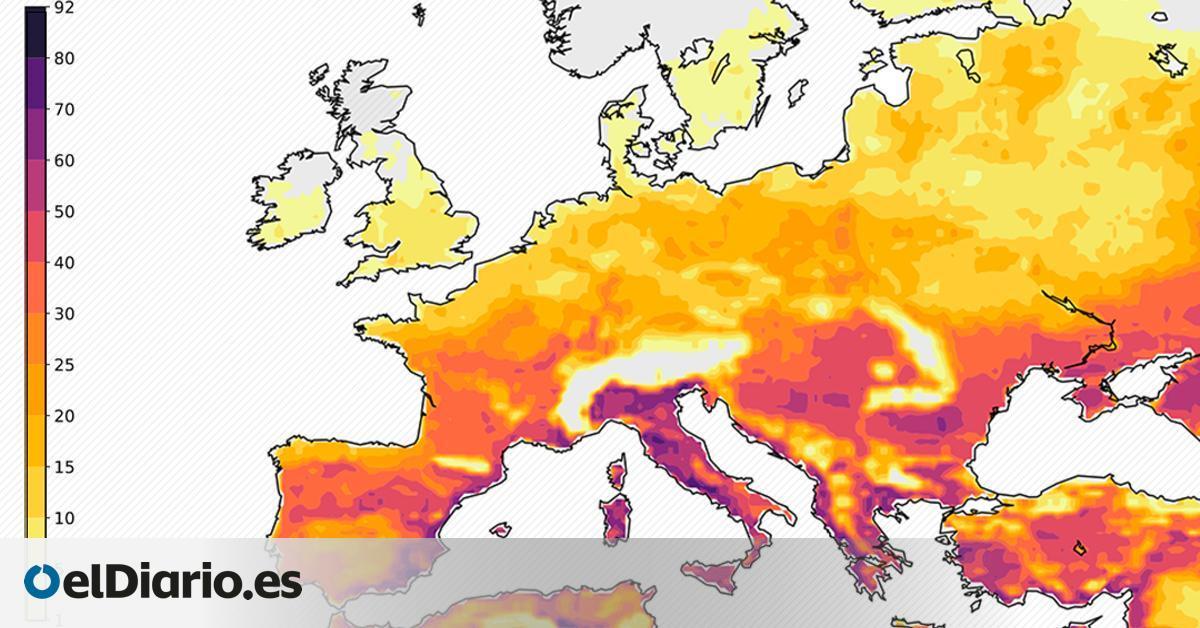
“Alarming changes in the European climate”. This is how the director of the Copernicus Climate Service, Carlo Buontempo, defines the temperature record certified in 2022, the “unprecedented” marine heat waves in the Mediterranean and, to top it off, “the extensive drought” that Europe has suffered in 2022.
Extreme heat kills the poor the most
Further
The data collected by Copernicus in its State of the Climate Report illustrates the new reality that is taking hold in a continent that is warming faster than any other: twice as much as the average for the planet. And attached come destructive phenomena such as forest fires and torrential rainfall that cause flooding.

Records and extreme weather events in Europe (2022)
Heat waves
affecting
much of Europe
in summer and in September,
in Greenland
fires
forestry
Czechia, France,
Slovenia, Spain
and the UK
storms
Three in
one week
Drought
Of spring
to summer in great
part of europe
Cold wave
Europe of
Norte
hello from
marine heat
west of
Mediterranean Sea
Strong rains
and floods
Bulgaria, Croatia, Italy,
Portugal, Slovenia
and Spain
GRAPHIC: IGNACIO SÁNCHEZ. SOURCE: COPERNICUS

Records and climatic phenomena
extremes in Europe (2022)
fires
forestry
Czechia, France,
Slovenia, Spain
and the UK
Heat waves
affecting great
part of europe
in summer and in
September,
in Greenland
storms
Three in
one week
Drought
Of spring
to summer in great
part of europe
Cold wave
Europe of
Norte
hello from
marine heat
west of
Mediterranean Sea
Strong rains
and floods
Bulgaria, Croatia, Italy,
Portugal, Slovenia
and Spain
GRAPHIC: IGNACIO SÁNCHEZ. SOURCE: COPERNICUS
All this means that, when talking about the climate crisis, in the end, it translates into consequences for the population. If the satellites measured the second warmest year and hottest summer on record, that meant people, especially in southern Europe, endured the most days (9% of the entire year) with severe stress for heat.
In Spain, most of the territory exceeded 25-30 days at that level, but large areas of the east and the interior went to more than 50 days in 2022, according to the data in the report. Here almost twice as much air conditioning is needed to combat the very high temperatures. Heat waves “are a health hazard,” recalls this report. And it hits the poorest the hardest.
Copernicus accumulates many measurements that describe how the climate in Europe continues to change. “The rise in temperatures is an important indicator,” says the Report. In the last five years, the average extra heat is 2.2ºC above pre-industrial times.
In this sense, between the fact that there was little snowfall and very high temperatures, the loss of ice in the glaciers of the Alps was at “unprecedented” levels. “The equivalent of more than 5 km3 of ice,” has calculated the Climate Service. And, once again, there were direct consequences for people: the avalanche caused by the breakage of the Italian glacier of La Marmolada caused 11 deaths in July 2022. The most disastrous effect was the melting of the once perpetual ice.
If the snow was scarce, the rains were also below reference levels. And the combination of less rainfall and rising heat has brought “one of the most significant phenomena that have affected Europe”, the drought.
So the European soil has been drier than ever: “The humidity of the land has been the lowest for 50 years”, they assess the data. And what is more, the flows of European rivers towards the sea registered the second lowest value, which has led to a chain of minimums for six years in a row. “63% of European rivers had flows below their average”.
The situation in Spain
When looking at the map of Spain, most of the large Iberian courses are between remarkably and exceptionally below the flow that reached the sea in August.
The meteorological drought has had an impact on some water reserves that were already highly demanded due to the high sustained demand. The rains –which in March and April in Spain were very abundant– could not recover the levels in the reservoirs. Then, the extraordinary heat and low rainfall have worsened the situation: the shortage to meet these levels of demand has become severe in many parts.
The high temperatures “highlight how the climate is changing”, as this document explains, and the abundance of extreme events illustrates the consequences. The map of the most serious episodes is spread across Europe: droughts, but also forest fires and very violent rainfall. If the focus on Spain is closed, a handful of all this has impacted the public.
“They are intensifying”, is the general conclusion of the Copernicus Service scientists. On the one hand, the fires in the forests caused the second largest forest area in European records to burn. Spain was the protagonist of some of the worst fires and one of the largest areas destroyed last year.
A palpable consequence of the climate crisis, the dry forests due to lack of water and the waves of high temperatures favor the expansion of the flames once the spark that causes the fire has jumped.
The fires were so many and so severe that the carbon emissions caused by burning vegetation were the highest on the continent in 15 years.
In addition to the heat waves on land, which lasted weeks and weeks in Spain during the summer, the Mediterranean Sea has suffered from very high temperatures since May 2022. Temperature records were broken on the Spanish coasts and days with records well above average. At the end of that trend, the world’s oceans have ended up exceeding the temperature record this April.
The list of extreme phenomena also includes torrential rains, which are associated with floods and floods. Once again, the people in Spain have been hit hard by these virulent storms.
In September, in the Canary Islands, in a few days as much water fell as the historical average for that entire month. A very high concentration of rain. In the Region of Murcia, these storms cost the life of a person. Air traffic was suspended on the islands of Tenerife and Gran Canaria.
A few months later, at the beginning of December, a new episode of very heavy and concentrated rains left as much water as the monthly average in 13 days. More than 24 provinces had to declare alert. A forest agent died in Salamanca.
The warming of the Earth, the unbalanced climate with its storms and its droughts are, ultimately, a consequence of the greenhouse effect caused by the gases released by human activities. In 2022, the concentrations in the atmosphere of CO2 and methane reached their maximum since they were measured by satellite. “We are running out of time”, the director of Copernicus, Mauro Facchini, wanted to recall after seeing the report.
Source: www.eldiario.es

